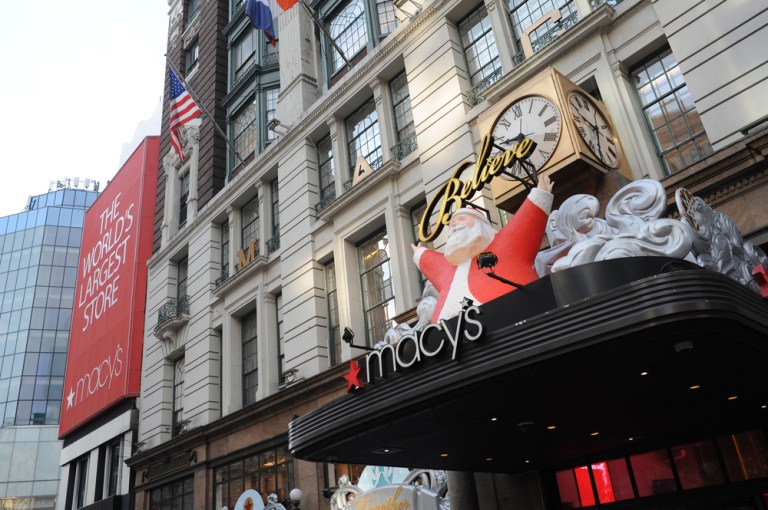
Yes, Macy’s earnings were better than the Street expected, but expectations were hardly a high bar. The sales declines continue, the guidance was soft, and yet, there were a few, okay, very very few bright spots, if you took the time to look Backstage…
While the upside is that it can be said Macy’s did manage to beat expectations when it reported its earnings today, it was hard for the market to take much solace in the veteran retail firm’s 10th straight quarter of declines — or its seemingly perennially falling sales figures.
Macy’s didn’t raise its guidance for the year and, in fact, missed consensus — thus indicating that whatever gains it managed to make during the quarter that ended in June were fragile at best.
By the Numbers
Macy’s did manage a better-than-expected result in the much-watched same-store sales category. Sales were down 2.8 percent as opposed to the 3.5 percent analysts expected. Earnings per share also came in a bit better than predicted, notching $0.48 a share, as opposed to the $0.45 analysts were looking for.
Chief Financial Officer Karen M. Hoguet stated on the conference call with analysts that comp sales on an owned-plus licensed basis were down 2.5 percent, better than had been seen in the first quarter of this year (thus showing sequential improvement), while also “somewhat better than we expected when we started the quarter.” Management noted that this came amid a backdrop of weak international tourist sales, which the company did not anticipate — down a whopping 9 percent. Tourist sales slippage hit comps by 40 basis points.
Looking ahead, guidance fell a bit short. Sales are expected to be down between 3.2 percent to as much as 4.3 percent. Looking at the bottom line, earnings are forecasted to be $2.90 to $3.15. That earnings range would exclude the impact of the sale of various assets. The earnings projections fell below the consensus of $3.27.
By the Merchandise
And yet, trends are showing that while management expects comps down 3 percent to 4 percent annually, the firm expects that the actual results will be in the “better” part of that range.
Leading to that relatively sanguine assessment in a period of admittedly stretched quarterly sales declines lies the fact that Macy’s has been able to capture sales from closed stores. The Backstage offering, the off-price part of Macy’s pantheon, added 6 percent in top line to the 38 stores that operate Backstage. Management also pointed to decent showings at Bloomingdale’s and Bluemercury stores. Overall, said CEO Jeffrey Gennette, 10 percent of Macy’s customers generate about 50 percent of the top line.
Merchandise changes are also having an impact in lessening the, well, negative impact. The company has finished its shoe rollout, which has been in pilot phase. (Shoes were up single digit percentages overall in the quarter.) Other merchandise mix changes included jewelry, furniture and mattresses that had a positive impact, while cosmetics were weak, as were housewares.
Digital sales remained positive, where strong performance has carried over into 32 straight double-digit growth quarters. Mobile has been a distinctly strong performer here, said the CEO. Income derived from credit transactions was also up, to the tune of $2 million year over year to $183 million. Credit income got a boost, said Hoguet, as people carried higher balances and have been slower to pay down those balances.
Said Gennette to analysts: “We have a lot of work ahead of us; I’m encouraged by what we’re starting to see,” as the firm looks for loyalty programs and the aforementioned initiatives to give a lift into the back end of the year.
But, said the CEO later in the call, “number one, we’re going to remain very promotional,” amid the 100 store closings that are planned for the near term.
In response to analyst questions as to overall inventory levels, Gennette stated that “we’re in a good position” and that some pressures remain on that line item, with housewares and tech watches selling with lower margins than traditional ones. Back-to-school shopping, he noted, has been showing “good signs, so far.”
Addressing online shopping — and, specifically, buy online and pickup in-store activity — Gennette spoke to a three-pronged strategy. He stated that 25 percent of all digital sales could be satisfied by merchandise being picked up in a store that has the same zip code as where that sale is being generated. Macy’s also has been striving to have mobile functionality in place that allows consumers to see the inventory available in a given store. That initiative, known as “Shop Your Store,” is in beta mode.